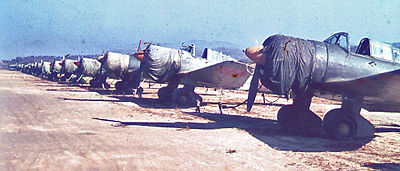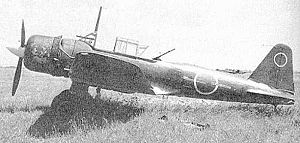- Mitsubishi Ki-51
-
Ki-51 Mitsubishi Ki-51 Role Type 99 Attacker Manufacturer Mitsubishi First flight mid-1939 Primary user Imperial Japanese Army Air Force Number built 2385 The Mitsubishi Ki-51 (Army designation "Type 99 Assault Plane". Allied nickname "Sonia") was a light bomber/dive bomber in service with the Imperial Japanese Army during World War II. It first flew in mid-1939. Initially deployed against Chinese forces, it proved to be too slow to hold up against the fighter aircraft of the other Allied powers. However, it performed a useful ground-attack role in the China-Burma-India theatre, notably from airfields too rough for many other aircraft. As the war drew to a close, they began to be used in kamikaze attacks. Total production was around 2,385 units.
On the day Hiroshima was destroyed by an atomic bomb, two Ki-51s scored the last Japanese victory against US submarines, and of which is confirmed as the 52nd USN submarine lost during the war; essentially, she would have been second to last, as USS Halibut (SS-232) was irreparably damaged in action months before Bullhead was lost, and was decommissioned in early 1945. Two depth charges hit USS Bullhead (SS-332), in which she later exploded and sank with all hands.
Charles Lindbergh, flying a P-38 Lightning shot down a Ki-51 after a vigorous dogfight in which the much slower Ki-51 utilized its low speed maneuverability and made a fight of it.
Contents
Versions
- Prototypes: 2 built
- Service trials: 11 built
- Ki-51: 2,3721 built (Manufacturers: Mitsubishi (1,462), Tachikawa Army Air Arsenal (913))
- Mansyu Ki-71: 3 protoypes of a tactical reconnaissance variant built by Mansyu with a retractable landing gear, did not enter production.[1]
Operators
- In 1945, Indonesian People's Security Force (IPSF) (Indonesian pro-independence guerrillas) captured a small number of aircraft at numerous Japanese air bases, including Bugis Air Base in Malang (repatriated 18 September 1945). Most aircraft were destroyed in military conflicts between the Netherlands and the newly proclaimed-Republic of Indonesia during the Indonesian National Revolution of 1945-1949.
- Communist Chinese (captured): The last 4 Ki-51s retired in 1953.
Specifications (Ki-51)
 Mitsubishi Ki-51 planes at the Seoul airport, 1945
Mitsubishi Ki-51 planes at the Seoul airport, 1945
Data from Japanese Aircraft of the Pacific War[2]
General characteristics
- Crew: Two
- Length: 9.21 m (30 ft 2⅝ in)
- Wingspan: 12.1 m (39 ft 8⅜ in)
- Height: 2.73 m (8 ft 11½ in)
- Wing area: 24.0 m² (259 ft²)
- Empty weight: 1,873 kg (4,129 lb)
- Loaded weight: 2,798 kg (6,169 lb)
- Max takeoff weight: 2,920 kg (6,415 lb)
- Powerplant: 1 × Mitsubishi Ha-26-II 14 cylinder air cooled radial engine, 709 kW (950 hp)
Performance
- Maximum speed: 424 km/h (229 kn, 263 mph)
- Range: 1,060 km (574 nmi, 660 mi)
- Service ceiling: 8,270 m (27,130 ft)
- Wing loading: 117 kg/m² (23.8 lb/ft²)
- Power/mass: 0.24 kW/kg (0.15 hp/lb)
- Climb to 5,000 m (16,400 ft): 9 min 55 sec
Armament
- Guns:
- 2× fixed, forward-firing 7.7 mm (.303 in) Type 89 machine guns (replaced with 2× 12.7 mm (.5 in) Ho-103 machine guns in later models)
- 1× 7.7 mm (.303 in) Te-4 Machine gun rearward-firing machine gun.
- Bombs: 200 kg (441 lb) bombs (normal operations); 250 kg (551 lb) for suicide operations[2]
See also
- Aircraft of comparable role, configuration and era
- Related lists
References
- Notes
- ^ Francillon 1979, p. 180.
- ^ a b Francillon 1979, p. 181.
- Bibliography
- Francillon, Ph.D., René J. Japanese Aircraft of the Pacific War. London: Putnam & Company Ltd., 1970. ISBN 0-370-00033-1 (2nd edition 1979, ISBN 0-3702-30251-6).
External links
- Mitsubishi Ki 51 Sonia in Virtual Aircraft Museum
- Mitsubishi Ki 51 Sonia at Warbirds Resource Group
- Mitsubishi Ki 51 Sonia at Pilotfriend
Aircraft produced by Mitsubishi Aircraft Company, Mitsubishi Heavy Industries,
and Mitsubishi Aircraft CorporationCompany designations Imperial Japanese Army short designations Imperial Japanese Navy short designations Japanese Self-Defense Force designations World War II Allied reporting names Aircraft produced by Tachikawa Imperial Japanese Army types World War II Allied reporting names Aircraft produced by Mansyū (Manshū) Imperial Japanese Army
designationsCivil aircraft Imperial Japanese Army Air Force aircraft designations 1-50 Ki-1 • Ki-2 • Ki-3 • Ki-4 • Ki-5 • Ki-6 • Ki-7 • Ki-8 • Ki-9 • Ki-10 • Ki-11 • Ki-12 • Ki-13 • Ki-14 • Ki-15 • Ki-16 • Ki-17 • Ki-18 • Ki-19 • Ki-20 • Ki-21 • Ki-22 • Ki-23 • Ki-24 • Ki-25 • Ki-26 • Ki-27 • Ki-28 • Ki-29 • Ki-30 • Ki-31 • Ki-32 • Ki-33 • Ki-34 • Ki-35 • Ki-36 • Ki-37 • Ki-38 • Ki-39 • Ki-40 • Ki-41 • Ki-42 • Ki-43 • Ki-44 • Ki-45 • Ki-46 • Ki-47 • Ki-48 • Ki-49 • Ki-50
51-100 Ki-51 • Ki-52 • Ki-53 • Ki-54 • Ki-55 • Ki-56 • Ki-57 • Ki-58 • Ki-59 • Ki-60 • Ki-61 • Ki-62 • Ki-63 • Ki-64 • Ki-66 • Ki-67 • Ki-68 • Ki-69 • Ki-70 • Ki-71 • Ki-72 • Ki-73 • Ki-74 • Ki-75 • Ki-76 • Ki-77 • Ki-78 • Ki-79 • Ki-80 • Ki-81 • Ki-82 • Ki-83 • Ki-84 • Ki-85 • Ki-86 • Ki-87 • Ki-88 • Ki-89 • Ki-90 • Ki-91 • Ki-92 • Ki-93 • Ki-94 • Ki-95 • Ki-96 • Ki-97 • Ki-98 • Ki-99 • Ki-100
100- World War II Allied reporting names for Japanese aircraft Aircraft in Japanese service Abdul • Alf • Ann • Babs • Baka • Belle • Betty • Bob • Buzzard • Cedar • Cherry • Clara • Claude • Cypress • Dave • Dick • Dinah • Dot • Edna • Emily • Eva • Eve • Frances • Frank • Gander • George • Glen • Goose • Grace • Gwen • Hamp • Hank • Hap • Helen • Hickory • Ida (Tachikawa Ki-36) • Ida (Tachikawa Ki-55) • Irving • Jack • Jake • Jane • Jean • Jerry • Jill • Jim • Judy • Kate • Kate 61 • Laura • Lily • Liz • Lorna • Loise • Louise • Luke • Mabel • Mary • Mavis • Myrt • Nate • Nell • Nick • Norm • Oak • Oscar • Pat • Patsy • Paul • Peggy • Perry • Pete • Pine • Rex • Rita • Rob • Rufe • Ruth • Sally • Sally III • Sam • Sandy • Slim • Sonia • Spruce • Stella • Steve • Susie • Tabby • Tess • Thalia • Thelma • Theresa • Thora • Tina • Tillie • Toby • Tojo • Tony • Topsy • Val • Willow • Zeke • Zeke 32
Nonexistent aircraft thought to be in Japanese service Adam • Ben • Doris • Gus • Harry • Ione • Joe • Joyce • Julia • June • Norma • Omar • Ray
Foreign aircraft erroneously thought to be in Japanese service Lists relating to aviation General Aircraft (manufacturers) · Aircraft engines (manufacturers) · Airlines (defunct) · Airports · Civil authorities · Museums · Registration prefixes · Rotorcraft (manufacturers) · TimelineMilitary Accidents/incidents Records Categories:- World War II Japanese dive bombers
- Mitsubishi aircraft
Wikimedia Foundation. 2010.

